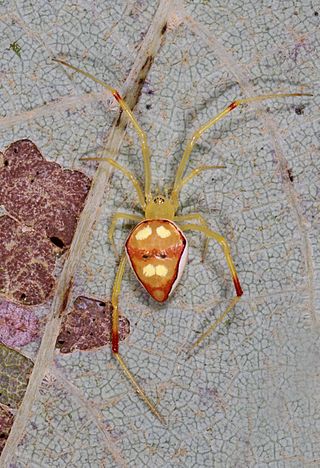
Spider-Man is a superhero appearing in American comic books published by Marvel Comics. Created by writer-editor Stan Lee and artist Steve Ditko, he first appeared in the anthology comic book Amazing Fantasy #15 in the Silver Age of Comic Books. He has been featured in comic books, television shows, films, video games, novels, and plays.

SpiderMonkey is an open-source JavaScript and WebAssembly engine by the Mozilla Foundation.

Theridiidae, also known as the tangle-web spiders, cobweb spiders and comb-footed spiders, is a large family of araneomorph spiders first described by Carl Jakob Sundevall in 1833. This diverse, globally distributed family includes over 3,000 species in 124 genera, and is the most common arthropod found in human dwellings throughout the world.

Orb-weaver spiders are members of the spider family Araneidae. They are the most common group of builders of spiral wheel-shaped webs often found in gardens, fields, and forests. The English word "orb" can mean "circular", hence the English name of the group. Araneids have eight similar eyes, hairy or spiny legs, and no stridulating organs.

Skylab 3 was the second crewed mission to the first American space station, Skylab. The mission began on July 28, 1973, with the launch of NASA astronauts Alan Bean, Owen Garriott, and Jack Lousma in the Apollo command and service module on the Saturn IB rocket, and lasted 59 days, 11 hours and 9 minutes. A total of 1,084.7 astronaut-utilization hours were tallied by the Skylab 3 crew performing scientific experiments in the areas of medical activities, solar observations, Earth resources, and other experiments.

The Foreigner is a fictional supervillain appearing in American comic books published by Marvel Comics. He was formerly married to Silver Sable. He was created by writer Peter David, and first appeared in Web of Spider-Man #15.
Spencer Smythe is a supervillain appearing in American comic books published by Marvel Comics. The character is usually depicted as an adversary of the superhero Spider-Man as well as the father of Alistair Smythe. A scientist researching robotics and arachnids, he turned to crime to finance his research, and dedicated his life to capturing Spider-Man. He is best known for creating the Spider-Slayers, robots designed specifically to hunt down, capture, or kill the web-slinger.

The Amazing Spider-Man is a side scrolling platform action video game released for the Nintendo Game Boy in 1990, published by LJN and developed by Rare based on the Marvel Comics superhero Spider-Man.

Argiope aurantia is a species of spider, commonly known as the yellow garden spider, black and yellow garden spider, golden garden spider, writing spider, zigzag spider, zipper spider, black and yellow argiope, corn spider, Steeler spider, or McKinley spider. The species was first described by Hippolyte Lucas in 1833. It is common to the contiguous United States, Hawaii, southern Canada, Mexico, and Central America. It has distinctive yellow and black markings on the abdomen and a mostly white cephalothorax. Its scientific Latin name translates to "gilded silver-face". The body length of males range from 5–9 mm (0.20–0.35 in); females range from 19–28 mm (0.75–1.10 in). These spiders may bite if disturbed or harassed, but the venom is harmless to non-allergic humans, roughly equivalent to a bumblebee sting in intensity.
Chinoscopus is a genus of jumping spiders that was first described by Eugène Louis Simon in 1901.

Episinus is a genus of comb-footed spiders that was first described by Pierre André Latreille in 1809.

Episinus angulatus is a small mottled brownish tangle-web spider, found from Europe to Russia.

Zygiella x-notata, sometimes known as the missing sector orb weaver or the silver-sided sector spider, is a spider species in the family Araneidae. They are solitary spiders, residing in daily spun orb webs. Z. x-notata is a member of the genus Zygiella, the orb-weaving spiders. The adult female is easily recognized by the characteristic leaf-like mark on her posterior opisthosoma, caudal to the yellow-brown cephalothorax.

The spider genus Spintharus occurs from the northeastern United States to Brazil. Nicholas Marcellus Hentz circumscribed the genus in 1850, initially as a monospecific genus containing his newly described species S. flavidus.

Chrosiothes is a genus of comb-footed spiders that was first described by Eugène Louis Simon in 1894. It is considered a senior synonym of Theridiotis.

The Artoriinae are a subfamily of wolf spiders. The monophyly of the subfamily has been confirmed in a molecular phylogenetic study, although the relationships among the subfamilies was shown to be less certain.

A spider web, spiderweb, spider's web, or cobweb is a structure created by a spider out of proteinaceous spider silk extruded from its spinnerets, generally meant to catch its prey.

Spiders are air-breathing arthropods that have eight limbs, chelicerae with fangs generally able to inject venom, and spinnerets that extrude silk. They are the largest order of arachnids and rank seventh in total species diversity among all orders of organisms. Spiders are found worldwide on every continent except for Antarctica, and have become established in nearly every land habitat. As of November 2023, 51,673 spider species in 136 families have been recorded by taxonomists. However, there has been debate among scientists about how families should be classified, with over 20 different classifications proposed since 1900.
Spintharus berniesandersi is a species of Spintharus in the family Theridiidae. It is endemic to Cuba. It was described in 2018 by Ingi Agnarsson and Lily Sargeant of the University of Vermont in a revision of the genus by Agnarsson and colleagues. S. berniesandersi was discovered alongside 14 other species of smiley-faced spiders. This revision is in contrast to Herbert Walter Levi's taxonomy, which considered it to be intraspecific variation within Spintharus flavidus.

Jennycliff Bay is a bay on the South West Coast Path in Plymouth, Devon, England. It is managed by Plymouth City Council and is both designated a County Wildlife Site (CWS) and part of the Site of Special Scientific Interest (SSSI) known as Plymouth Sound, Shores and Cliffs. From its upper grassy area, the bay overlooks Mount Batten and Plymouth Sound.

















